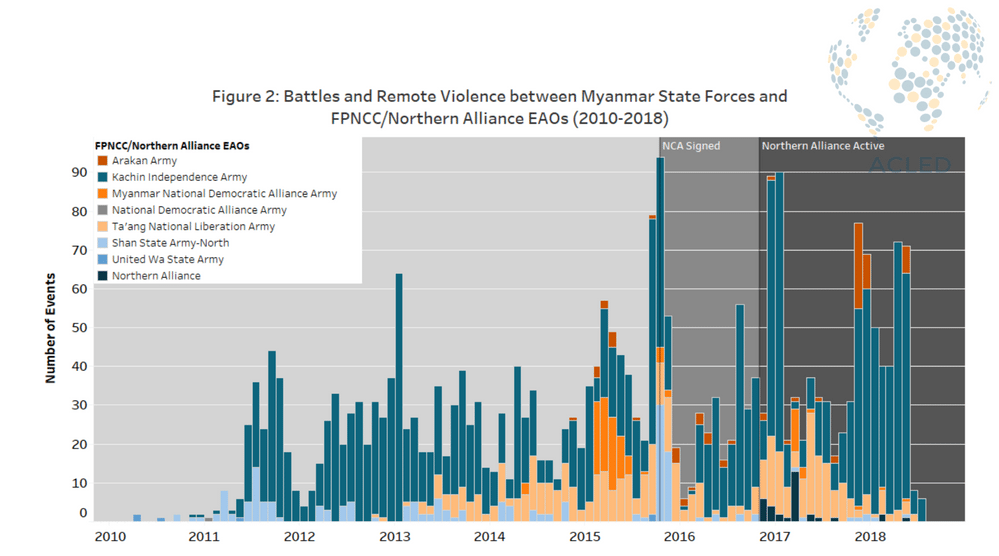With the Myanmar military pressuring all ethnic armed organizations (EAOs) to sign the Nationwide Ceasefire Agreement (NCA), non-signatory EAOs have responded by forming a loose military alliance, called the Northern Alliance, to strengthen their position against the military. As with many alliances in Myanmar’s history, the cohesiveness and long-term viability of the alliance is uncertain. Increased military operations by the Myanmar military against the groups in this alliance, particularly the increased use of remote violence, has resulted in the alliance groups shifting their tactics both politically and militarily.
In 2016, four EAOs formed the Northern Alliance. The driver behind the formation of the Northern Alliance was the Kachin Independence Army (KIA) which has been in conflict with the Myanmar military for several decades. From 1994-2011, the KIA had a bilateral ceasefire agreement with the Myanmar military which held. The conflict reignited in 2011 after the KIA rejected the military’s Border Guard Force (BGF) scheme which would have placed the KIA under the control of the military. At the time, the Myanmar military also had increased its presence in the Kachin region to guard the Chinese construction of the Myitsone Hydropower Dam which exacerbated tensions, leading eventually to the start of the current war.
The KIA has since sought to strengthen its position by providing training and support to the Arakan Army (AA), the Ta’ang National Liberation Army (TNLA), and the Myanmar National Democratic Alliance Army (MNDAA). These four groups have fought alongside one another as allies in many battles, sometimes fighting as the ‘Northern Alliance’ and other times fighting jointly without the moniker.
Since 2016, there has been a significant increase in the use of remote violence between Myanmar state forces and the Northern Alliance groups (see Figure 1). This is primarily due to the Myanmar military’s increased use of air strikes, mortars, and heavy artillery to attack the groups’ positions. When the conflict with the KIA restarted, the KIA was at a slight advantage for a ground war given their familiarity with the mountainous terrain in Kachin and northern Shan state. The Myanmar military’s increased use of remote violence to wage war has put the KIA and allied groups at a disadvantage and has contributed to a shift in the alliance’s tactics. When the Northern Alliance attacked military and police outposts in northern Shan state in November 2016, they attributed their actions to the losses that they were suffering due to the Myanmar military’s aerial offensives and the resulting difficulty of fighting in the jungle, thus leading them to carry out an offensive on state forces based in an urban area.
However, this attempt to shift tactics backfired and was met with even greater force by the Myanmar military which led in December 2016 and January 2017 to the highest level of conflict between state forces and the Northern Alliance groups since the signing of the NCA (see Figure 2). The battle for the KIA outpost of Gideon was particularly severe.
In the following months, the Northern Alliance groups shifted their political strategy, moving closer to the Chinese-supported United Wa State Army (UWSA). In April 2017, the Northern Alliance and the UWSA, as well as the National Democratic Alliance Army (NDAA) and the Shan State Army-North (SSA-N), announced the formation of the Federal Political Negotiation and Consultative Committee (FPNCC).[1] By allying with the UWSA, the largest EAO in Myanmar, the Northern Alliance moved from being primarily a military alliance to a political alliance. With a force of around 30,000 troops, and Chinese supplied weaponry, any sustained military engagement with the UWSA would likely result in heavy losses for the Myanmar military thus deterring any such engagement.
While the Myanmar military initially refused to negotiate with the FPNCC/Northern Alliance due to the inclusion of the AA, TNLA, and MNDAA (all groups lacking previous bilateral ceasefire agreements with the military), all members of the FPNCC/Northern Alliance attended the most recent session of the 21st Century Panglong Union Peace Conference as observers and met on the sidelines, albeit in separate groups, with the military and the government.
Despite these political and military alliances, there has been some intergroup conflict within the FPNCC/Northern Alliance. The TNLA and SSA-N have reportedly clashed at least four times around Namtu township, Shan state. They clashed twice in December 2017 and twice in May 2018. The clashes appear to be the result of territorial disputes and point to the underlying tensions between EAOs in Myanmar and the fragility of alliances, an issue sometimes overlooked given the shared conflict with the Myanmar military.
For the time being, though, the FPNCC/Northern Alliance is likely to hold. In April and May 2018, there was a sharp increase in the Myanmar military’s campaign against the KIA with the continued use of remote violence. The TNLA launched a surprise offensive attack on government security posts in the town of Muse in Shan state in May, citing the Myanmar military offensive against their ally, the KIA, as the reason for the attack. The Myanmar military strategy of using remote violence and the corresponding attempts by the alliance groups to launch offensive attacks seems likely to continue.
[1] The seven EAOs that comprise the alliance are sometimes referred to by both names interchangeably in media sources. They are referred to in this analysis as the FPNCC/Northern Alliance.








